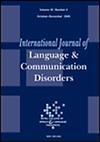Prediction of Speech Impairment in Patients Treated for Oral or Oropharyngeal Cancer Using Automatic Speech Analysis
Abstract
Background
Perceptual evaluation of speech disorders produces scores that poorly predict the consequences of speech impairment on the communication abilities of patients treated for oral/oropharyngeal cancer. This may be mitigated by automatic speech analysis.
Aim
To measure communication and speech impairment using automatic analyses of spontaneous speech and self-administered questionnaires in patients treated for oral cavity or oropharyngeal cancer.
Methods and Procedures
The spontaneous speech of 25 patients was recorded during a semistructured interview. Various acoustic and automatic tools were applied to the speech signal to obtain scores relating to the different linguistic levels. Reduction of dimensionality was applied to retain only relevant and nonredundant parameters. Self-administered questionnaires assessing communication and associated factors (associated deficits, anxiety/depression, cognitive status, communication needs relating to social circles, self-perception of speech impairment and quality of life) were conducted. A predictive modelling of communication and speech impairment by LASSO regression was performed using the scores from the automatic tools alone, which were then combined with the scores arising from the questionnaires.
Outcomes and Results
A total of 149 automatic parameters were extracted from the speech signal, of which 75 were retained after dimensional reduction. Predictive modelling of communication and speech impairment [Holistic Communication Score (HoCoS)] using the selected automatic parameters (number of sonants and occlusives recognised per second) provides a correlation of 0.83 between the predicted and actual score. This modelling is reliable (rS = 0.82 between five-fold cross-validation and HoCoS). The correlation reaches 0.89 when including associated factors in the modelling, while maintaining a high reliability (rS = 0.70 between five-fold cross-validation and HoCoS).
Conclusions and Implications
The use of automatic speech analysis allows a reliable prediction of the communication and speech impairment experienced by the patients. This study opens up new perspectives for the use of automatic speech recognition systems in clinical evaluation and for the consideration of functional and psychosocial needs expressed by the patients during their follow-up.
WHAT THIS PAPER ADDS
- Automatic and acoustic analyses compensate for the biases of perceptual speech assessment in clinical practice. Although they are used to assess speech severity, few studies have examined their contribution to the measurement of communication and speech impairment, which is yet an essential objective of clinical intervention.
- Acoustic and automatic analyses (and in particular the use of automatic speech recognition systems) enable good prediction of communication and speech impairment reported by patients, with a limited number of tools and parameters. This prediction is even improved by adding to the models scores from self-questionnaires measuring functional and psychosocial dimensions that may be impacted by the speech disorder. This study provides reliable new tools for measuring impaired communication.
- Acoustic and automatic tools can be used in routine clinical care to obtain a valid and reliable measure of communication and speech impairment. This prediction leads to a follow-up score to quantify the level of communication and speech impairment at a given time and the evolution of patients from a speech sample.


 求助内容:
求助内容: 应助结果提醒方式:
应助结果提醒方式:


